Bill Mitchell – The Passionate Design Maestro.
 Wednesday, April 26, 2017 at 07:54AM
Wednesday, April 26, 2017 at 07:54AM Editor's Note: Peter is doing research for a future Rant this week, so we're re-running one of his most-requested columns today - a look at the legendary Bill Mitchell and the glory days of GM design. This column was adapted for Peter's book, The United States of Toyota, and stands as an enduring reminder of GM's truly incredible design history. Enjoy! -WG
By Peter M. De Lorenzo
Detroit. To say that the ‘50s and ‘60s were a different era in automotive history is not painting a proper picture of just how different it was. Detroit was much more of a freewheeling mindset back then. Car executives were bold, decisive, conniving, creative and power-hungry personalities who inevitably went with their gut instincts – which could end up being either a recipe for disaster or a huge runaway sales hit on the streets. The only committees you'd find back then were the finance committees – and they never got near the design, engineering, marketing or even the advertising unless there was some sort of a problem. These Car Kings worked flat-out, and they partied flat-out, too, ruling their fiefdoms with iron fists while wielding their power ruthlessly at times to get what they wanted – and rightly so in their minds – as they were some of the most powerful business executives on earth. In short, it was a world that was 180 degrees different from what goes on in today's rigid, namby-pamby, never-have-a-point-of-view-and-never-take-a-stand automotive environment.
No one represented the spirit of the business back then more than Bill Mitchell. He was bold, powerful, flamboyant, recalcitrant, maniacal, brilliant, frustrating and probably every other adjective you can think of for someone who was one of a kind. He was smart enough to know and he had the innate sense to understand that he had inherited the legacy of the great Harley Earl, and he never for a second forgot that fact – or let anyone else forget it either. And he played it for all it was worth with a swagger and strut that haven't been seen since. He often bumped heads with the "suits" down at the corporation when they didn't "get" one of his design recommendations – but he usually won the battles and got his way.
Mitchell was, in fact, his own potentate within the GM monolith, and he did outrageous things and spoke his mind and generally didn't give a rat's ass about any of the other bullshit that was part of corporate life at GM at the time. Mitchell was a larger-than-life personality, and it just didn't sit well with a lot of the sober financial suits down on the "14th floor" of the old GM building. He swaggered and strutted his way around the Design Staff like it was his own personal kingdom – and make no mistake about it – it was.
To give you just a small glimpse into how Mitchell held sway over things at Design Staff, the Corvette was the one car that meant more to him than any other. And whenever a young designer did a version and started to gloat even just a little bit, Bill would always set things straight with the following famous Mitchell-ism: "Don't flatter yourself, kid – I'm the one who does Corvettes here." (As a brief aside, one of the most hilarious things I ever witnessed as a kid was watching the mercurial Mitchell attempt to play golf at the Bloomfield Hills Country Club. He was horrible at it, and his frustration level would grow exponentially with each hole – and you could see his complexion glow even more beet-red than it already was almost by the minute. He had absolutely no patience for the game whatsoever, and finally he'd inevitably storm off the course without finishing his round and jump into one of his concept cars – the original Sting Ray, the Mako Shark, the Monza SS – you name it, and then he'd peel out of the parking lot spinning the tires and grabbing gears all the way down Long Lake Road.)
I've heard countless firsthand stories about the man and his ballistic fits in studios while cajoling his troops to go further and reach higher – but I saw a slightly different side to him too.
Because, after all, he lived just a block away from our house...
And I'll never forget the day I discovered that fact. I was still in my bike-riding days back then, but I remember resting with my buddies one blistering Friday afternoon on a corner in our neighborhood after a long, hot day of riding around aimlessly – we did that often back then – when we heard a rumble and roar coming from off in the distance. I knew right away that it wasn't motorcycles and that it was more than one of whatever it was – and just then a pack of the most stunning cars we'd ever seen burst around the corner and came rumbling right past us – the sun glinting off the barking pipes and the canopy of trees shimmering off the perfect mirror finishes of the paint jobs. This "horsepower train" was led by the "original" Corvette Stingray in Silver, followed by the XP700 Corvette (a "bubble-top" show car with side pipes also in Silver – it was Mitchell's favorite color), the first Mako Shark Corvette and a concept called the Corvair Sebring Spyder (also in Silver), a wild racing-inspired show car with dual cut-down racing windscreens and three pipes curling out and around each side in the back. They were so loud we couldn't even hear ourselves screaming whatever it was we were screaming, but after a split second to think about it, we took off, pedaling our guts out after them. It was apparent that these machines were heading for our part of the neighborhood – and as we tried to keep them in sight I realized they were turning on to my cross street!
We came around the corner and saw them pull into a driveway, exactly one block from my house. We stopped right at the end of the driveway with our mouths gaping down to the asphalt, as the drivers of the other cars handed the keys to the driver of the Stingray and he took them up to the front door where a woman collected them. Then, an Impala pulled up and the four men got in it and were gone, leaving the cars sitting in the driveway all lined up ticking and spitting as their pipes started to cool.
This became the Friday Afternoon Ritual of the summer – at least when Bill Mitchell was in town.
He liked having his "toys" at his disposal on the weekends. And every weekend the collection was different, depending on the mood he was in when he made the call to the Styling garage. I would watch what cars would be delivered on Friday, and then I would ride over there on Saturdays and just linger out in the driveway studying every square inch of every car hoping to get an audience with The Man himself – and maybe, just maybe – a ride in one of the machines. One thing about Bill Mitchell is he never got tired of the cars, and he never got tired of seeing people's reaction to them or answering questions about them. After about the third weekend of this, I finally got the nerve to introduce myself to him one Saturday morning as he was getting ready to go somewhere in the Sebring Spyder. From that moment on I was okay in his book because I was "one of Tony's boys" and he said, "Hop in – I'm just running up to the drug store, but come on..."
I jumped in the passenger seat (the interior was done in Silver Metallic leather), and he made sure I fastened my seatbelt, even though he didn't bother with his – and we were off. The Sebring Spyder was a revelation to me (although I had to look through the cut-down windscreen or off to the side to see) because it was the first time I had been in anything other than a production automobile. Thanks to my brother, I had ridden shotgun in plenty of fast cars, but this was different – this one was exotic to me. The ride literally lasted five minutes up to the store and five minutes back, but from then on I was a fixture in the Mitchell's driveway for the rest of the summer.
I ended up riding in every one of GM's Concept Cars of that era. All but one of them being chauffeured by none other than Bill Mitchell himself. Just for the record, my favorites were the original Stingray, the Monza GT Coupe in Silver and the Monza SS Spyder in Red (look them up – they were the stunning Corvair-based show cars with the front ends eerily similar to the racing Chaparrals).
Oh, and the one not chauffeured by Bill Mitchell? That was an unbelievably wild Pontiac show car called the XP400. It started out as a 1964 Nassau Blue Pontiac Bonneville convertible that had more of a '50s custom look to it (complete with a stowable hard tonneau cover that was way ahead of its time). Big deal, you say? Well, stuffed in the engine bay was a 421-cubic-inch, Mickey Thompson-prepared drag race motor with a 671 GMC blower producing, as Ken Eschebach (the gifted technician at "Styling" who basically kept everything running for Mitchell) said, "All Mickey said was that it had almost 700 h.p." Oh, and one more thing – it had a lever that you could engage that would open up un-muffled side-pipes any time you felt the urge to.
Bill Mitchell had the XP400 dropped off one summer day in 1964 for my older brother to play with for the weekend. I have two memories of that weekend: 1. Sitting in the back seat with two other guys (a total of five in the car) rolling down a two-lane road headed for Woodward Avenue – in first gear. My brother punched it, and that beast shrieked and howled as it charged down the road, spinning its rear tires in the first three gears, our necks snapping in unison with every shift. The acceleration almost took the wind out of me. He backed out of it at 125 only because we had to stop for a light. The thing was brutally fast – a truly nasty-beautiful machine in every sense of the word. And 2. Pulling into gas stations and getting out to check the oil just so we could see the expression on the attendant's face as we unlatched the hood. And we did that often because Mickey had set the motor up with "drag race piston rings" as Ken told us, so it used 21 quarts of oil in one weekend. Incredible...
Things weren't all blissful in those years. I heard rumblings of things being "different" in the Mitchell household, and the next thing I knew he had gotten divorced – and then he got remarried to a woman who lived around the corner from us, one block away in the opposite direction! I guess he liked the neighborhood.
At any rate, Bill Mitchell's new wife had a stepson (though several years younger than our crowd) who became part of our bike-riding gang. It was during this time that I really got to know Bill Mitchell beyond the occasional car rides. I used to hang out in his basement for hours with his stepson, and I'll never forget what a shrine to the automobile it was – a virtual museum of automotive art and automobilia. The man had his favorite drawings plastered all over the place – beautiful illustrations from the time he first started drawing cars as a young boy that were lit with little spotlights. He had personally signed photos of most of the all-time great Grand Prix drivers from the '30s, '40s, '50s and early '60s. He had a Plexiglas case containing the helmet, goggles and gloves that the great Rudolph Carraciola wore in one of his last drives for the Mercedes-Benz factory racing team (I finally understood why Mitchell's favorite color was Silver – he had Silver Mercedes-Benz and Auto Union stuff everywhere). He had other personal effects from famous drivers all over the place – a Stirling Moss helmet, gloves from the great Juan Manuel Fangio – you name the driver, and he had something personally signed by them and given to him. And there were countless models, original paintings, pictures, plaques and badges – a cornucopia of car stuff that is just staggering to think about now.
There were a few times when he would come down and spend time with us, and since I thought I wanted to be a car designer I'd pepper him with questions about anything and everything. I remember one particular day when he was in an expansive mood, and he took me on a personal guided tour of his collection of stuff – and it was one of the most fascinating experiences of my life. Here was a living automotive legend in every sense of the word taking the time to convey to a kid what all of this stuff really meant to him. What struck me right away was how he was as much of a pure fan and in awe of his favorite drivers as anyone. He expounded on every single piece of memorabilia – where it came from, how it came about, his personal experiences with the driver, etc. But the best part was when I'd ask him about a particular drawing he had done, and he'd go off for several minutes explaining every nuance, every line and every shape down to the last detail.
In that brief moment of time, I finally understood the passion, the intensity and the love for everything automotive that was Bill Mitchell. And I realized right then and there that my love for everything automotive had some sort of place in life – and maybe even a future – all because Bill Mitchell took the time to give a kid a tour of his personal automotive museum.
For all that has been said and written about Bill Mitchell – the tough-guy persona, the bluster, and all the stories and anecdotes of his temper tantrums in the studio – I think people forget what a truly gifted and talented man he was. And I also think people have forgotten how his relentless, unwavering passion for the automobile and automotive design inspired countless young designers and helped propel General Motors to the top of the automotive design world in his day. Something that was truly lost on this company for the longest time.
Right now, there are car guys and gals from many disciplines slogging away at every car company on the planet – and maybe even some will read this column. An elite few of them may have even managed to rise to the top in their car companies with their spirit and passion intact, which is no mean feat in this day and age.
But in the face of a business that grows more rigid, regulated and non-risk-taking by the day, there are still lessons to be learned from the legacy of Bill Mitchell. If anything, we must remember what really matters in this business above all else – something he instinctively knew in his gut – and that is to never forget the essence of the machine, and what makes it a living, breathing mechanical conduit of our hopes and dreams. And that in the course of designing, engineering and building these machines everyone needs to aim higher and push harder – with a relentless, unwavering passion and love for the automobile that is so powerful and unyielding that it can't be beaten down by committee-think or buried in bureaucratic mediocrity.
Bill Mitchell had an uncanny knack for getting the best out of the talented people around him. And he led the only way he knew how – and that was by fueling creativity with his passion and by the sheer force of his will. What he believed in is as true and vibrant today as it was in his era – and hopefully, at least in some quarters of a few car companies, that will always be the case.
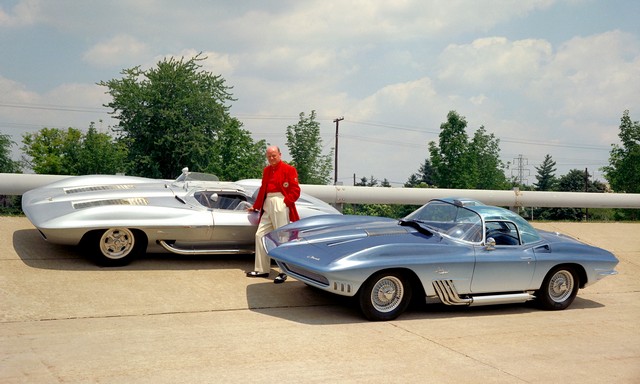
(GM Design)
Bill Mitchell stands next to two of the most iconic GM designs under his reign: The 1959 Corvette Stingray racer concept (XP87), and the 1961 Corvette Mako Shark (XP-755) concept. A 19-year-old Peter Brock (who later went on to design the Cobra Daytona Coupe for Carroll Shelby), Larry Shinoda and Mitchell himself worked on the Stingray racer in 1957, which obviously influenced the fabulous '63 Corvette Stingray production car, and Shinoda and Mitchell worked on the Mako Shark concept. One of the countless anecdotes from the Mitchell era? He caught a Mako shark on a fishing trip in Florida and had it mounted on a wall in his office. He kept telling the designers that he wanted the paint job on the Mako Shark concept to look exactly like the shark on his wall, with the same color gradations. After Mitchell rejected several attempts at painting the XP-755 concept car and amid growing frustration, a few designers sneaked into his office late one night while Mitchell was out of town and removed the shark from his office wall. They then had the paint shop paint Mitchell's prized catch exactly like the latest paint job on the Mako Shark concept. They then put the shark back up on his wall and presented the new paint job on the Corvette Mako Shark concept to Mitchell, who pronounced it "perfect." -PMD
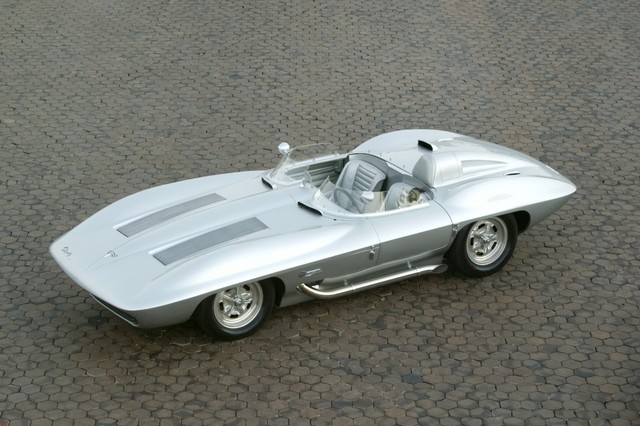
(GM Design)
The stunning 1959 Corvette Stingray racer is still sensational to this day (and the Autoextremist's all-time favorite car). When (now retired) Ed Welburn took over GM Design, one of his first orders of business was to commission the complete restoration of this iconic vehicle, and it remains the unquestioned jewel of GM's collection of historic vehicles.
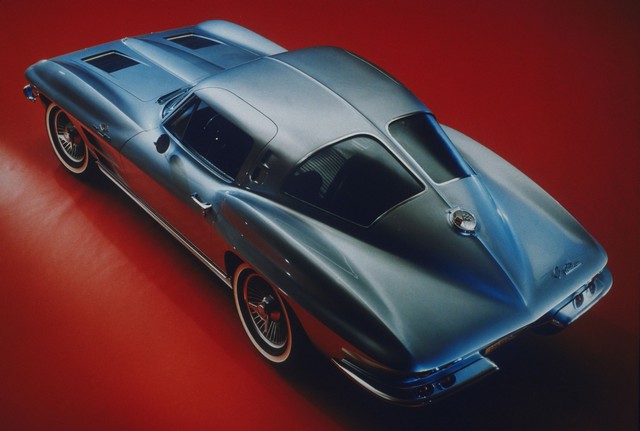
(GM Design)
The 1963 Corvette Stingray is still fabulous to this day. The "split" rear window design was one of its signature design elements but it only appeared for one model year. Zora Arkus-Duntov, the famous Corvette Chief Engineer in its formative years and an automotive legend in his own right, vehemently despised the design detail and fought with Bill Mitchell tooth and nail over it in one of the monumental internal battles in GM history. Mitchell won that battle but Duntov won the war, as the design detail was gone on the 1964 model Corvette.
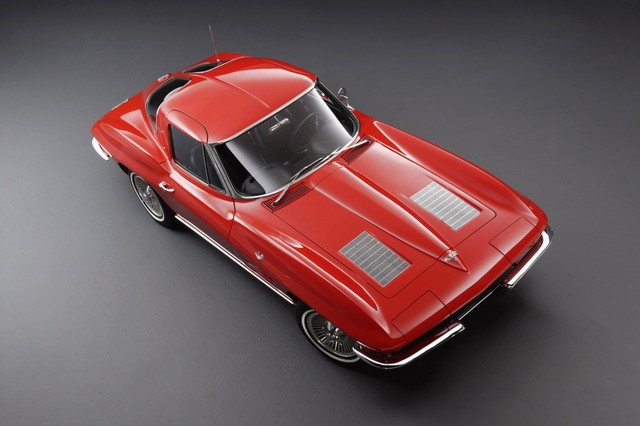
(GM Design)
The introduction of the 1963 Corvette Stingray remains one of the most memorable debuts in American automotive history.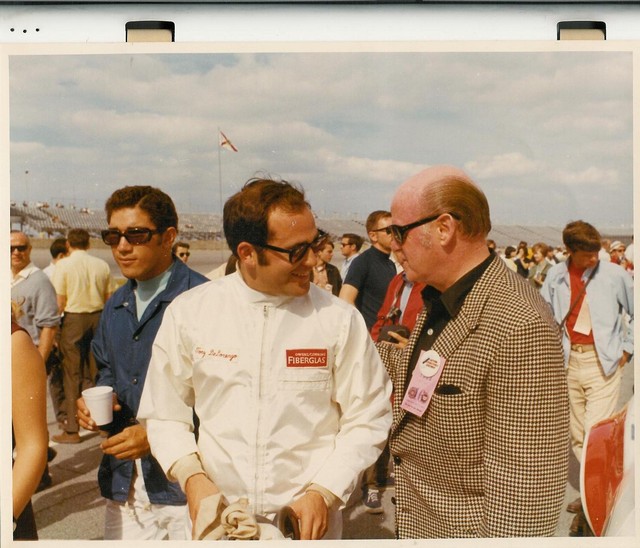
(Photo by Roger Holliday/The DeLorenzo Collection)
Bill Mitchell visits with Peter's brother Tony on the grid before the Daytona 24 Hour race in 1969. The Owens/Corning Corvette Racing Team made its official international racing debut at Daytona that year and Mitchell stopped by to say hello. Mitchell loved being around race tracks and would often bring advanced GM concept cars up to Road America in Elkhart Lake, Wisconsin, to take the pulse of racing enthusiasts. The Corvette Stingray racer used a spare chassis from the ill-fated, one-off, factory-entered Corvette SS, which appeared at Sebring in 1957. Mitchell took the Corvette SS chassis and re-bodied it into the Stingray racer and raced it privately on his own dime, with famous Corvette Racer Dick Thompson, "The Flying Dentist" at the wheel. The Stingray racer made its debut at Road America, painted red (below). Once the development of the 1963 Corvette Stingray production car program started taking shape, Mitchell "retired" the Stingray racer and painted it a gleaming metallic silver (his favorite color), which was reminiscent of the Mercedes Grand Prix machines from the 50s, his favorite racing cars.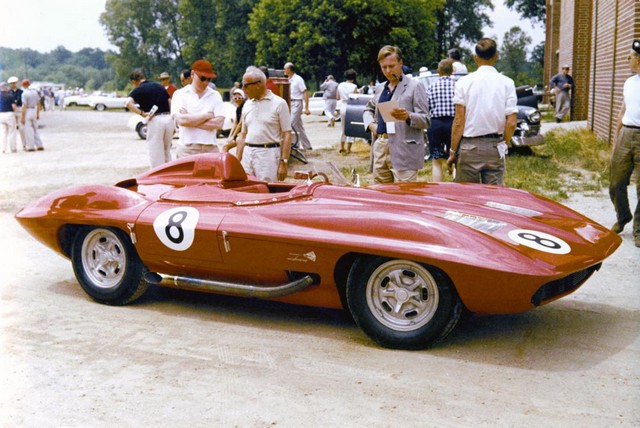 (Corvettestory.com)
(Corvettestory.com)






